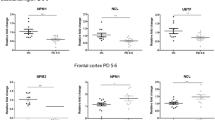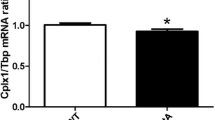Abstract
Synucleins are proteins known for their malfunction in a group of illnesses called synucleopathies, which includes Alzheimer's and Parkinson's disease. To learn more about the role of synucleins in the CNS, we have studied levels of message coding for α-, β-, and γ-synuclein using quantitative RT-PCR. Levels of synuclein mRNAs were studied in the cerebral cortex (left and right, anterior and posterior), hippocampus, striatum, and cerebellum, obtained from 5-d-old (newborn), 1-mo (juvenile)-, and 6-, and 9-mo (adult)-old rats. The mRNA levels for all synucleins varied significantly among structures. The rank order of mRNA levels in different structures was cortex=hippocampus>striatum>cerebellum for α-synuclein; cortex>hippocampus=cerebellum >striatum for β-synuclein; and hippocampus=striatum>cortex=cerebellum for γ-synuclein. There was significant effect of age for mRNA levels for all synucleins. The dynamics of these changes were different depending on type of synuclein and brain structure. Levels of mRNA for α-synuclein were significantly reduced with age in all structures except hippocampus. For β- and γ-synuclein, levels increased significantly only in the cerebral cortex and only from 5 d to 1 mo of age. In contrast, γ-synuclein levels in the cerebellum were very high at 5 d and significantly reduced at 1 mo of age. The revealed pattern and dynamics of changes in the levels of mRNA coding for synucleins would support the conclusion for an important role of these molecules during development and the aging process.
Similar content being viewed by others
References
Brenz Verca M. S., Bahi A., Boyer F. Wagner G. C., and Dreyer J. L. (2003) Distribution of alpha- and gammasynucleins in the adult rat brain and their modification by high-dose cocaine treatment. Eur. J. Neurosci. 18, 1923–1938.
Buchman V. L., Adu J., Pinon L. G., Ninkina N. N., and Davies A. M. (1998) Persyn, a member of the synuclein family, influences neurofilament network integrity. Nat. Neurosci. 1, 101–103.
Chomczynski P. and Sacchi N. (1987) Single-step method of RNA isolation by acid guanidinium thiocyanatephenol-chloroform extraction. Anal. Biochem. 162, 156–159.
Clayton D. F. and George J. M. (1998) The synucleins: a family of proteins involved in synaptic function, plasticity, neurodegeneration and disease. Trends Neurosci. 21, 249–254.
Clayton D. F. and George J. M. (1999) Synucleins in synaptic plasticity and neuro degenerative disorders. J. Neurosci. Res. 58, 120–129.
Di Rosa G., Puzzo D., Sant'Angelo A., Trinchese F., and Arancio O. (2003) Alpha-synuclein: between synaptic function and dysfunction. Histol. Histopathol. 18, 1257–1266.
Hsu L. J., Mallory M., Xia Y., Veinbergs I., Hashimoto M., Yoshimoto M., et al. (1998) Expression pattern of synucleins (non-Aß component of Alzheimer's disease amyloid precursor protein/α-synuclein) during murine brain development. J. Neurochem. 71, 338–344.
Jin H. and Clayton D. F. (1997) Synelfin regulation during the critical period for song learning in normal and isolated juvenile zebra finches. Neurobiol. Learn. Mem. 68, 271–284.
Kholodilov N. G., Neystat M., Oo T. F., Lo S. E., Larsen K. E., Sulzer D., and Burke R. E. (1999) Increased expression of rat synuclein in the substantia nigra pars compacta identified by mRNA differential display in a model of developmental target injury. J. Neurochem. 73, 2586–2599.
Lavedan C., (1998) The synuclein family. Genome Res. 8, 871–880.
Li J. Y., Henning Jensen P., and Dahlstrom A. (2002) Differential localization of alpha-, beta- and gammasynucleins in the rat CNS. Neuroscience 113, 463–478.
Li W., Lesuisse C., Xu Y., Troncoso J. C., Price D. L., and Lee M. K. (2004) Stabilization of alpha-synuclein protein with aging and familial parkinson's disease-linked A53T mutation. J. Neurosci. 24, 7400–7409.
Liang T., Spence J., Liu L., Strother W. N., Chang H. W., Ellison J. A., et al. (2003). α-Synuclein maps to a quantitative trait locus for alcohol preference and is differentially expressed in alcohol-preferring and-non-preferring rats. Proc. Natl. Acad. Sci. U. S. A. 100, 4690–4695.
Maroteaux L. and Scheller R. H. (1991) The rat brain synucleins; family of proteins transiently associated with neuronal membrane. Brain Res. Mol Brain Res. 11, 335–343.
Mash D. C., Ouyang Q., Pablo J., Basile M., Izenwasser S., Lieberman A., and Perrin R. J. (2003) Cocaine abusers have an overexpression of alpha-synuclein in dopamine neurons. J. Neurosci. 23, 2564–2571.
Miller D. W., Hague S. M., Clarimon J., Baptista M., Gwinn-Hardy K., Cookson M. R., and Singleton A. B. (2004) Alpha-synuclein in blood and brain from familial Parkinson disease with SNCA locus triplication. Neurology 62, 1835–1838.
Neystat M., Lynch T., Przedborski S., Kholodilov N., Rzhetskaya M., and Burke R. E. (1999) Alpha-synuclein expression in substantia nigra and cortex in parkinson's disease. Mov. Disord. 14, 417–422.
Ostrerova N., Petrucelli L., Farrer M., Mehta N., Choi P., Hardy J., and Wolozin B. (1999) α-Synuclein shares physical and functional homology with 14-3-3 proteins. J. Neurosci. 19, 5782–5791.
Perez R. G., Waymire J. C., Lin E., Liu J. J., Guo F., and Zigmond M. J. (2002) A role for alpha-synuclein in the regulation of dopamine biosynthesis. J. Neurosci. 22, 3090–3099.
Petersen K., Olesen O. F., and Mikkelsen J. D. (1999) Developmental expression of alpha-synuclein in rat hippocampus and cerebral cortex. Neuroscience 91, 651–659.
Pinhasov A., Ilyin S. E., Crooke J., Amato F. A., Vaidya A. H., Rosenthal D., et al. (2005) Different levels of gamma synuclein mRNA in the cerebral cortex of dominant, neutral and submissive rats selected in the competition test. Genes Brain Behav. 4, 60–64.
Surgucheva I., McMahan B., Ahmed F., Tomarev S., Wax M. B., and Surguchov A. (2002) Synucleins in glaucoma: implication of gamma-synuclein in glaucomatous alterations in the optic nerve. J. Neurosci. Res. 68, 97–106.
Surguchov A., McMahan B., Masliah E., and Surgucheva I. (2001a) Synucleins in ocular tissues. J. Neurosci. Res. 65, 68–77.
Surguchov A., Palazzo R. E., and Surgucheva I. (2001b) Gamma synuclein: subcellular localization in neuronal and non-neuronal cells and effect on signal transduction. Cell Motil. Cytoskeleton 49, 218–228.
Author information
Authors and Affiliations
Corresponding author
Rights and permissions
About this article
Cite this article
Malatynska, E., Pinhasov, A., Crooke, J. et al. Levels of mRNA coding for α-, β- and γ-synuclein in the brains of newborn, juvenile, and adult rats. J Mol Neurosci 29, 269–277 (2006). https://doi.org/10.1385/JMN:29:3:269
Received:
Accepted:
Published:
Issue Date:
DOI: https://doi.org/10.1385/JMN:29:3:269




